This article first appeared in Homespun Beginners and Beyond: Crochet Issue 2. It has been edited to focus upon Tunisian Crochet Hooks.
Walk into any large variety store or ‘big box’ craft store and you’ll probably see a small display of steel, plastic, aluminium or bamboo standard crochet hooks. Along with readily available acrylic yarn, this is usually where beginners start. The new crocheter watches a YouTube video on how to crochet and instantly becomes frustrated with their inability to create their chosen masterpiece. The yarn is undone countless times and begins to split. The hook tip just won’t do what it’s told. Sound familiar? This was my experience. This image shows my first couple of hook purchases. The bottom two are still used but the top two are only kept as examples of my most hated hooks.
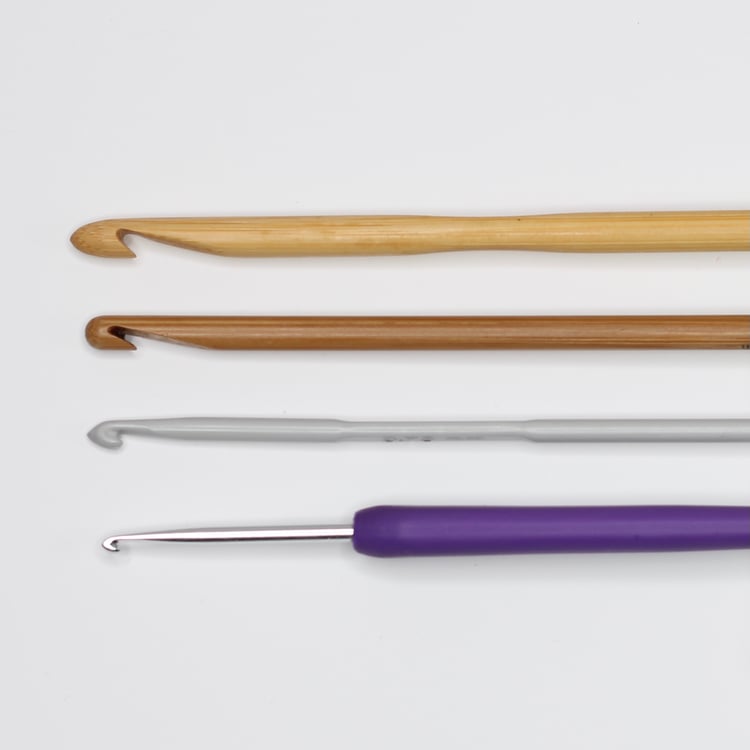
Something that those totally new to crochet often don’t know is that, those easily accessible crochet hooks are not favoured by those ‘in the know’. Crochet hooks have come a long way from those cold little grey hooks you can find in the obvious places. So where to start?
Let’s look at the anatomy of a hook
Point: The very tip of the hook.
Throat: This is the sloped part just after the hook point.
Shaft: This is where you measure your hook diameter.
Thumb rest: Stamped or carved after the throat – some hooks don’t have a thumb rest.
Handle: The part of the hook held in the hand.
Mouth/bowl: Holds the yarn while being pulled through stitch/es.
Lip/nose: Keeps the yarn in the mouth/bowl while making stitches.

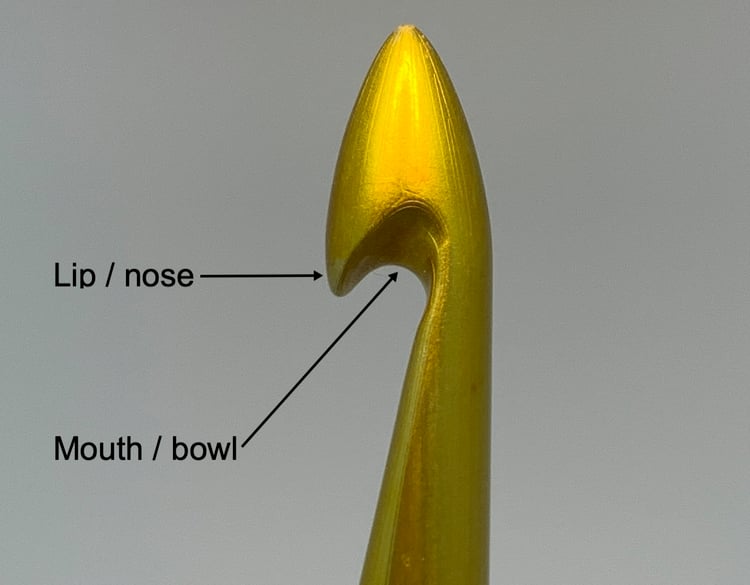
Considerations
Material: Timber, laminated timber (layers of timber glued and pressed together), aluminium, bamboo, plastic, steel. Many crocheters like working in one material in cold weather and another when it’s hot. In Australia it’s prudent to factor in our humid weather. Bamboo hooks can feel awful when it’s humid and steel hooks can be squeaky. Metal hooks can upset some hands with long-term use in the cold. Timber and bamboo can chip/splinter if not stored well and catch on fine fibres.
Thumb grip: A thumb grip is carved, or machine pressed into the hook itself. Often the hook size and brand is stamped into the thumb grip which gives it a raised texture. Some tunisian crocheters love a thumb grip and they can be hard to come by.
Handle: An ergonomic handle rather than a thumb grip can be ideal for those with health issues such as arthritis. It stops the hand pinching in too closely when crocheting.
Hook tip: Blunt, sharp, long or short. The preference for a certain type of hook shape is often determined by the type of stitches being worked and the style of crocheter. None are wrong but opinions can differ markedly about what style is best! The hooks in this image are my favourite hook tips. They were all made by CATCH.
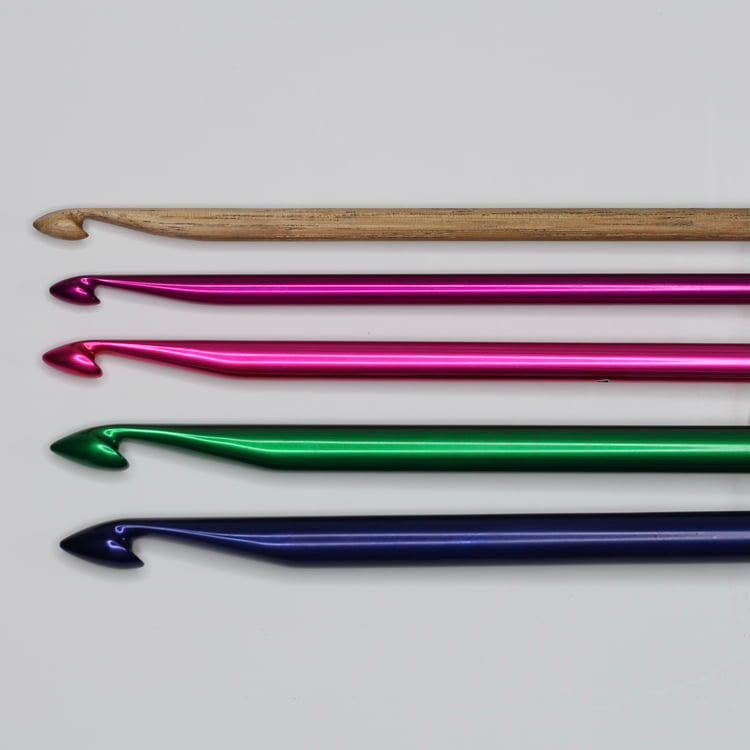
Lip/nose: Some hooks have a lip that is longer or shorter than necessary. These hooks can be frustrating to use as yarn can slip off a hook with a short lip and a long lip takes more movement to pull yarn out of the bowl. Look for a lip somewhere in between.
Also keep an eye out for a lip that protrudes out wider than the shaft. This hook unnecessarily widens holes to get the lip through, distorting the size of the stitch.
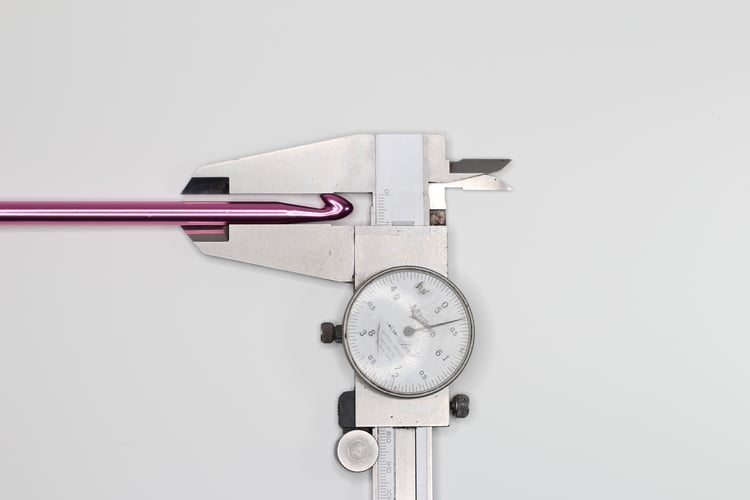
Machine versus handmade: Machine made hooks are made by pressing or cutting a set shape. There is little to no curving of the hook parts, especially on the throat and lip. Hooks are consistent and uniform.
Handmade hooks are literally carved by hand, especially the tip, lip and mouth. The below image shows a commercial brand of hand carved standard and Tunisian hooks. I purchased these hooks individually at the start of my crocheting and none are the same. This isn’t necessarily bad but is something to consider.
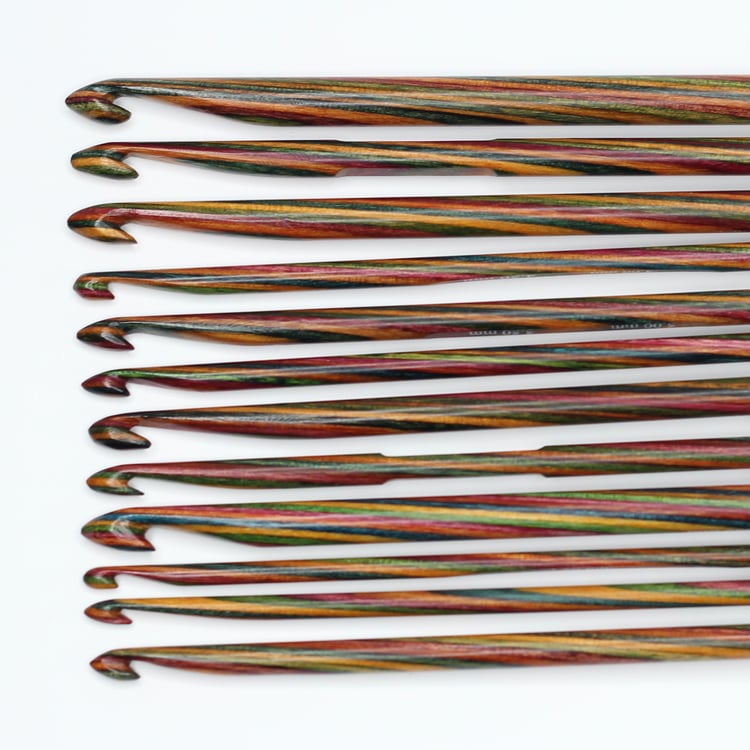
Price: Expensive doesn’t always equal ‘good’. Some of the most expensive hooks I’ve purchased are rarely used because there is something about them I don’t enjoy. Alternatively, many cheap hook sets available are also nasty. A middle range is often the most ideal.
Availability: Some hook brands are hard to source in some countries. Be aware that some large online platforms are awash with copies – if purchasing online, look for reputable sellers.
Tunisian crochet hooks
Some functions of standard crochet hooks are not ideal for Tunisian crochet. Thumb grips and handles do not suit long rowed Tunisian crochet and the pointiness of a hook is often more important. Despite this, the points described above are almost all relevant to choosing Tunisian crochet hooks as well as standard crochet hooks. Consider the previous points along with the style of hook you want to work with.
There are three main styles of Tunisian crochet hooks.
Singled ended: A rigid, long hook with a stopper at one end and a hook on the other. Lengths range from around 25cm to 40cm.
Double ended: Usually a rigid shaft with a hook at both ends. You can use a double ended hook to work in the round using a spiral method (perfect for beanies and cowls). It can also be used in flat pieces to assist with colourwork. (One strand of yarn makes the forward pass and anther strand makes the return pass).

Interchangeable: A hook at one end of the shaft and a thread (screw in) or clip to attach a cable at the other end. A stopper is connected to the far end of the cable. These hooks are good for long rows such as blankets when there are too many stitches to have on a shorter, rigid hook. My favourite use for these hooks is to work in the round in rows (not a spiral) which is especially useful in garments. You can also turn these into double ended hooks with a hook at both ends of the cable.
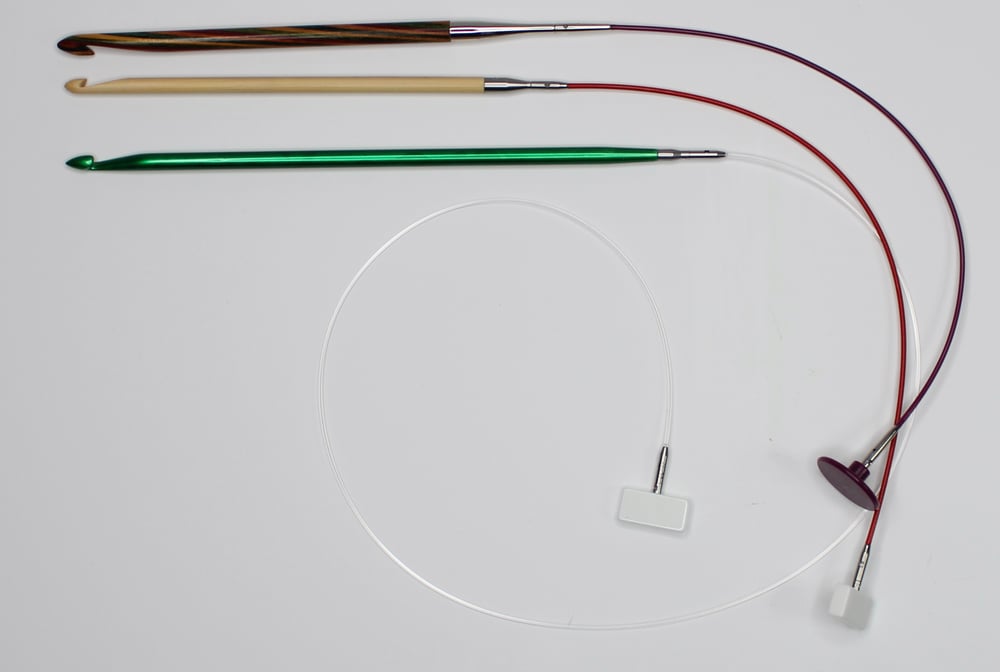
Many brands have sets of interchangeable Tunisian crochet hooks. Before investing, I recommend testing out a single hook in case you decide that brand isn’t for you.
Double ended hooks are much harder to find. Some brands don’t make them at all and some that do have a different hook size at each end. If this is all you can find, use the larger size for the forward pass and the smaller size for the return pass. A double ended hook can be used for single ended applications by either ignoring the hook at one end or attaching an elastic band to one end as a stopper. Dual purpose hooks can be a way to save a bit of your hard-earned cash.
Here’s my two cents
Every experienced crocheter you speak to will probably have a strong view about their favourite hooks. For example, I really don’t like thumb grips, but I know many people who love them. I also refuse to use a round hook tip as they just won’t go through the holes I want them to. This is because I crochet firmly. A loose tensioned crocheter may love a round tip because they’re less likely to stab themselves with a pointy hook than I am!
Views will sometimes depend on the history of the crocheter. For example, I don’t knit. I learned Tunisian crochet before I learned standard crochet. In consequence, I favour pointed hooks, as do many Tunisian crocheters. And I don’t like thumb grips because they get in the way of loops of Tunisian stitches that fill the length of the hook. I use my Tunisian hooks for standard crochet because I like them so much! A lot of knitters I know will gravitate to a hook with an ergonomic handle because it stops arthritis flaring up.
The most important thing is that there are no rights and wrongs, there are just preferences and availability. Choose what you can afford, arm yourself with a bit of know-how and just go for it!
A bit about CATCH hooks
You may have noticed that I don't use commercial hooks all that much. This is because when I first started out, the only Tunisian hooks I could find were interchangeable ones and I wanted to work in double ended hooks - I couldn't find double ended hooks with the same size at both ends!
My husband, Haemish is a very handy person with a shed full of engineering tools. So he had a 'crack' at making timber TC hooks. His first attempts were ok and have evolved over time. He started out just making timber single and double ended hooks for crafters my Mum and I knew. And it grew.
I got annoyed that I couldn't find aluminium cabled hooks. I had KnitPro (Knitters Pride in USA) but I didn't love them. Some of the laminates came apart when I used splitty wool and their standard purple cables didn't spin. So the cables used to fight me. Then someone told me about Dyakcraft.... but they didn't make aluminium hooks any more.
Always up for a challenge, Haemish decided to try his hand at anodising. Sending aluminium off for commercial anodising can be really expensive and time consuming. He bought the right chemicals and electrical parts and the rest is history. His anodising can be done in straight colours or sometimes he has a play with multiple colours on his hooks.
He can make anodised aluminium hooks in double ended, single ended and interchangeable. They're compatible with both KnitPro (Knitters Pride) cables and ChiaoGoo cables. And what's more exciting, KnitPro cables now come in a 'swivel' option and are easier to find than ChiaoGoo cables (and a bit cheaper).
It's just a side hustle for him so you'll only find him on Instagram and Facebook. All the information about his hooks is available on a separate page on this website.
I don't mind if you think I'm biased about CATCH hooks, after all, I live with a hook maker so it makes sense that I use them a lot. I've tried lots of other hooks though and I just love these. They're an investment but I have the philosophy that when you can, use the good tools, crochet with the nice yarn and show off what you finish!
Abbey
PS: I've made a video all about hooks too. Here it is!


Comments ()